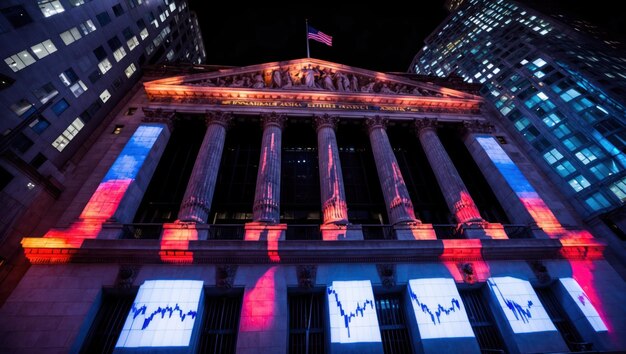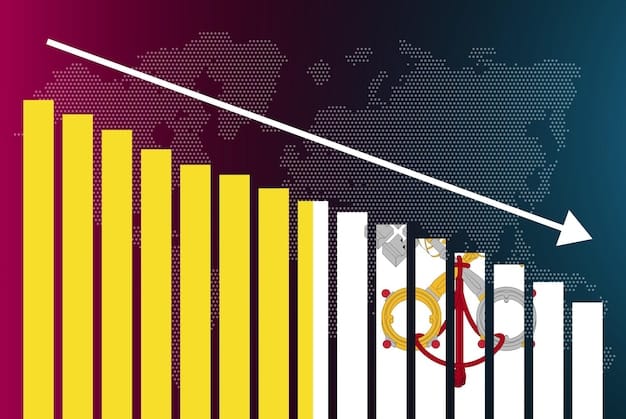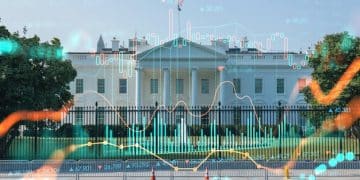Fed’s Rate Decision: Impact on Your Business Explored

The Federal Reserve’s latest interest rate decision directly influences borrowing costs, investment opportunities, and consumer spending, thereby reshaping the operational and strategic landscape for businesses across the United States in various sectors.
The latest announcement from the Federal Reserve about interest rates is more than just headline news; it’s a pivotal moment that can significantly reshape the economic landscape for every business. Understanding what this decision entails and, more importantly,
Breaking: Federal Reserve Announces Key Interest Rate Decision – What Does It Mean for Your Business?
is crucial for strategic planning and financial stability. This article delves into the implications, offering insights for businesses navigating these changes.
Understanding the Federal Reserve’s Role and Decision-Making
The Federal Reserve, often referred to as the Fed, functions as the central bank of the United States. Its primary responsibilities include conducting monetary policy, supervising and regulating banking institutions, maintaining financial stability, and providing financial services to depository institutions.
Through its actions, the Fed aims to achieve two main objectives: maximum employment and price stability. These are often referred to as the “dual mandate.” The interest rate decisions are a key tool in this endeavor, designed to influence the broader economy.
When the Fed adjusts its benchmark interest rate, known as the federal funds rate, it doesn’t directly set the rates consumers or businesses pay. Instead, it influences the rate at which banks lend to each other overnight. This, in turn, cascades through the financial system, affecting a wide range of other interest rates.
How the Federal Funds Rate Works
The federal funds rate serves as a foundational benchmark. When it changes, other rates—like those for mortgages, car loans, and business lines of credit—typically follow suit. A lower federal funds rate generally translates to lower borrowing costs for banks, which they can then pass on to their customers. Conversely, a higher rate makes borrowing more expensive.
- Influences short-term borrowing costs for banks.
- Impacts consumer loans, including credit cards and mortgages.
- Affects business borrowing for expansion and operations.
- Signal of economic health and the Fed’s outlook.
The Federal Open Market Committee (FOMC) is the branch of the Federal Reserve System that determines the direction of monetary policy. They meet several times a year to assess economic conditions and decide whether to raise, lower, or maintain the federal funds rate, considering factors such as inflation, employment numbers, and global economic trends.
The recent decision is a direct outcome of thorough analysis by the FOMC, reflecting their current assessment of the economic climate and their strategy to either cool down an overheating economy or stimulate growth, depending on prevailing conditions.
Immediate Impacts on Borrowing Costs and Capital Access
One of the most direct and immediate consequences of a Federal Reserve interest rate decision is its effect on borrowing costs. For businesses, this translates into changes in the expense associated with securing capital for various needs.
If the Fed raises interest rates, the cost of borrowing typically increases. This affects everything from short-term operating loans to long-term investment capital. Businesses planning expansions, equipment purchases, or even managing their daily cash flow will see higher interest payments.
Conversely, a rate cut makes borrowing more affordable, potentially encouraging businesses to take on new projects, invest in research and development, or expand their workforce. The availability of cheaper capital can act as a stimulant for growth and innovation.
Credit Lines and Loans
Many businesses rely on credit lines and variable-rate loans for their operational flexibility. Changes in the federal funds rate often directly impact the interest rates on these financial products. A hike means higher monthly payments and a tighter budget for interest expenses.
- Variable-rate loans become more expensive with rate hikes.
- Fixed-rate loans taken before a hike might look more favorable.
- New capital expenditure projects become costlier to finance.
- Access to credit may become tighter as lenders adjust to risk.
Beyond traditional loans, the decision can also influence the appetite of investors in the bond market. Higher interest rates often make government bonds more attractive, potentially drawing capital away from corporate bonds and other private investments, which could make it harder for businesses to raise funds through debt issuance.
For startups and small businesses, the impact can be particularly acute. They often have less access to diverse funding sources and are more sensitive to fluctuations in borrowing costs, making careful financial planning even more critical.
Impacts on Consumer Spending and Demand
The Federal Reserve’s interest rate decisions don’t just affect businesses directly through borrowing costs; they also have a profound influence on consumer behavior, which, in turn, impacts demand for products and services. When interest rates rise, consumers typically face higher costs for mortgages, car loans, and credit card debt.
This increase in household expenses can lead to a tightening of consumer budgets, reducing discretionary spending. People might postpone large purchases, opt for cheaper alternatives, or simply save more, fearing future economic uncertainty. This shift in spending habits directly affects businesses, particularly those in retail, hospitality, and durable goods sectors.
A decrease in interest rates, on the other hand, can free up disposable income and make borrowing more attractive for consumers. This often stimulates demand, encouraging spending on everything from housing to entertainment, providing a boost to businesses that cater to these markets.
Sector-Specific Consumer Responses
Different sectors will experience these shifts in consumer behavior differently. Businesses selling necessities might see relatively stable demand, albeit with consumers potentially trading down on brands. Luxury goods or discretionary services, however, are often the first to feel the pinch.
- Automotive sales face headwinds due to higher car loan rates.
- Real estate market cools as mortgage rates increase, impacting construction and related industries.
- Retailers may see reduced foot traffic and sales, especially for non-essential items.
- Savings rates might increase as higher interest rates make saving more appealing.
For businesses, understanding these consumer dynamics is key to adjusting sales forecasts, marketing strategies, and inventory levels. Anticipating a potential slowdown in demand after a rate hike, or a surge after a cut, allows for proactive measures to mitigate risks or capitalize on opportunities.
The ripple effect extends to business-to-business (B2B) enterprises as well. If consumers buy less, businesses that supply products and services to consumer-facing companies will also experience a corresponding decline in demand, creating an interconnected chain of impact throughout the economy.

Investment and Expansion Decisions for Businesses
The Federal Reserve’s interest rate moves play a critical role in shaping the investment and expansion strategies of businesses. Access to affordable capital is foundational for growth, and changes in interest rates directly influence this.
When rates are low, the cost of capital is less, making long-term investments in new technologies, expanded production facilities, or market penetration more financially viable. Businesses are more likely to take on debt to fuel growth, as the potential returns on investment can more easily outpace borrowing costs.
Conversely, in a rising interest rate environment, the hurdle rate for new projects increases. Companies become more selective about their investments, prioritizing projects with higher guaranteed returns or lower risk. Some expansion plans might be shelved or scaled back due to increased financing expenses.
Strategic Planning Adjustments
Financial officers and corporate strategists closely monitor the Fed’s announcements. These decisions necessitate a re-evaluation of financial models, budgeting, and long-term strategic plans. Companies with significant capital expenditure plans often accelerate or defer them based on interest rate forecasts.
- Evaluating new machinery or technology purchases becomes more sensitive to interest rates.
- Mergers and acquisitions, often funded by debt, might slow down with higher rates.
- Research and development budgets could be scrutinized more closely.
- Companies might prioritize debt reduction over expansion in a high-rate environment.
The venture capital and private equity markets also respond to these changes. Higher interest rates can make investors more cautious, demanding quicker returns and more robust business models before committing capital. This, in turn, can affect the funding landscape for startups and innovators.
Businesses that rely heavily on exporting products may find their competitiveness impacted. If higher rates strengthen the dollar, US goods become more expensive for international buyers, potentially reducing export volumes and requiring a reassessment of international market strategies.
Impacts on Inflation and Supply Chains
The Federal Reserve uses interest rate adjustments as a primary tool to combat inflation. When inflation is high, the Fed typically raises rates to slow down economic activity, thereby reducing demand and, theoretically, price pressures. This strategy has a direct, albeit sometimes delayed, impact on businesses.
Higher interest rates can eventually lead to a cooling of consumer demand, which in turn can ease pressure on supply chains that have been struggling with excess demand. For businesses, this might mean a reduction in raw material costs and transportation expenses, which have been significant drivers of inflation.
However, the transition period can be challenging. Businesses might face softening demand while still dealing with elevated costs from past inflationary pressures. Managing inventory and pricing strategies during this phase requires careful balancing.
Supply Chain Resilience
In recent years, supply chain disruptions have highlighted vulnerabilities in global trade. While interest rates don’t directly fix these issues, the overall economic environment shaped by Fed policy can influence how businesses invest in supply chain resilience.
- Reduced demand can alleviate logistical bottlenecks.
- Businesses may find it cheaper to finance investments in local sourcing or automation.
- Lower inflation expectations can stabilize raw material prices.
- Strategic stockpiling might become less attractive if borrowing costs are high.
Furthermore, the Fed’s actions often influence currency exchange rates. A stronger dollar, often a consequence of higher interest rates, can make imported goods cheaper for US businesses, potentially helping to lower input costs. However, it also makes US exports more expensive, affecting companies reliant on international sales.
Businesses need to monitor not only the interest rate changes but also their downstream effects on inflation and supply chain dynamics. Adjusting procurement strategies, supplier relationships, and inventory management based on these evolving conditions is crucial for maintaining profitability and operational efficiency.
Strategic Responses and Future Outlook for Businesses
In response to the Federal Reserve’s interest rate decisions, businesses must adopt proactive and adaptable strategies to mitigate risks and capitalize on new opportunities. This requires a thorough internal financial review and an external market analysis.
Businesses should reassess their debt structures, considering whether to refinance variable-rate loans before potential further rate hikes or to lock in current rates if cuts are anticipated. Cash flow management becomes even more critical, with an emphasis on optimizing working capital and maintaining healthy liquidity.
On the revenue side, understanding the sensitivity of their customer base to economic shifts is paramount. Businesses may need to adjust pricing, introduce new product lines, or explore new markets to sustain demand in a challenging environment. Diversification of revenue streams can also provide a buffer against volatility.
Navigating Economic Shifts
The economic outlook following a Fed decision is rarely straightforward. Businesses should prepare for various scenarios, from a rapid economic slowdown to a gradual stabilization. Agility in decision-making and the ability to pivot strategies quickly are invaluable assets.
- Focus on operational efficiencies and cost control to maintain margins.
- Invest in technology that improves productivity and reduces reliance on costly inputs.
- Strengthen customer relationships to retain market share amidst increased competition.
- Explore government support programs or alternative financing options if traditional credit tightens.
For long-term planning, businesses should consider how current interest rate trends might influence future growth opportunities. This includes evaluating the cost-benefit of long-term investments, such as facility upgrades or sustainability initiatives, which might yield significant returns despite higher initial financing costs.
Ultimately, the Fed’s decision serves as a reminder for businesses to remain vigilant and strategically flexible. By carefully analyzing the implications and implementing well-considered financial and operational adjustments, businesses can not only weather economic changes but also emerge stronger.

Preparing for Future Rate Adjustments and Economic Volatility
Beyond the immediate impact of a single Federal Reserve interest rate decision, businesses must cultivate a robust framework for anticipating and responding to future adjustments and broader economic volatility. The Fed’s policy is dynamic, reacting to continuously evolving economic data.
This necessitates that businesses adopt a forward-looking approach to financial planning. Building scenarios that account for different rate trajectories—whether further hikes, cuts, or prolonged stability—can help in stress-testing existing strategies and identifying potential vulnerabilities or untapped opportunities.
Developing strong cash reserves is a prudent measure, offering a cushion against unexpected financial pressures and the ability to seize dislocated assets or opportunities during downturns. Diversifying investment portfolios, both for the business itself and for any corporate treasury, can also de-risk financial exposure.
Developing Resilience and Agility
An emphasis on organizational resilience and agility is paramount. This includes having flexible supply chains that can adapt to disruptions, a versatile workforce capable of shifting roles, and technological infrastructure that supports remote work and digital transformation.
- Regularly review debt obligations and consider restructuring if market conditions become favorable.
- Implement sophisticated financial modeling to predict the impact of various economic scenarios.
- Foster strong relationships with financial institutions to ensure access to capital even in challenging times.
- Continuously monitor economic indicators beyond interest rates, such as inflation, employment, and GDP growth.
For small and medium-sized enterprises (SMEs), engaging with business advisors or industry associations can provide valuable insights and support in navigating complex economic landscapes. These resources often offer tailored advice and access to networks that can help mitigate risks.
Ultimately, the ability of a business to not just survive but thrive amidst economic volatility hinges on its preparedness. Proactive planning, continuous monitoring of economic signals, and a commitment to operational flexibility will be key determinants of success in an environment shaped by Federal Reserve decisions.
| Key Point | Brief Description |
|---|---|
| 💰 Borrowing Costs | Fed rate changes directly impact loan interest for businesses and consumers. |
| 📉 Consumer Demand | High rates reduce disposable income, lowering consumer spending and demand. |
| ⚙️ Business Investments | Rate hikes make expansion and R&D more costly, potentially slowing growth. |
| 📈 Inflation Control | Fed uses rates to curb inflation, influencing supply chain costs and pricing strategies. |
Frequently Asked Questions About Fed Interest Rates
The federal funds rate is the benchmark interest rate set by the Fed, influencing how much banks charge each other for overnight loans. This rate trickles down to affect all other interest rates, including those for business loans, credit lines, and mortgages, directly impacting a company’s borrowing costs for expansion and operations.
Higher interest rates typically lead to increased costs for consumer loans and credit, reducing household disposable income. This often results in decreased discretionary spending, potentially lowering demand for non-essential goods and services. Businesses, particularly in retail and hospitality, might experience a slowdown in sales.
Businesses should focus on optimizing cash flow, reviewing debt structures, and prioritizing investments with strong, assured returns. Consider hedging against rising borrowing costs if possible, and implement cost-saving measures. Diversifying revenue streams and enhancing operational efficiency can help maintain profitability and stability.
Yes, significantly. Higher interest rates increase the cost of capital, making it more expensive to finance new projects, expansions, or equipment purchases through debt. This can lead to a re-evaluation of investment thresholds, potentially delaying or shelving less critical projects in favor of those with higher, more immediate returns.
The Federal Reserve often raises interest rates to combat high inflation by cooling down economic growth and reducing demand. While this can eventually ease price pressures on supply chains and raw materials for businesses, there might be a challenging transition period of slowing demand coupled with existing high costs.
Conclusion
The Federal Reserve’s interest rate decisions are a cornerstone of economic policy, sending reverberations throughout every sector of the business world. From the immediate shifts in borrowing costs and consumer spending to the long-term implications for investment and strategic planning, these announcements demand careful attention and proactive responses. Businesses that understand the multifaceted impacts and adapt their financial and operational strategies accordingly will be best positioned to navigate the evolving economic landscape, ensuring resilience and fostering sustainable growth in an environment shaped by the Fed’s ongoing vigilance.





